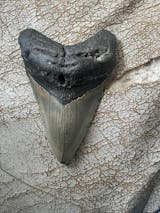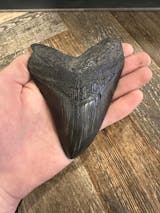🦈 Ultimate Guide: How to Start a Megalodon Tooth Collection
Few fossils capture the imagination quite like the tooth of a Megalodon — the largest predatory shark that ever existed. Holding one feels like holding time itself, a piece of ancient ocean history that’s survived millions of years beneath the seafloor.
Whether you’ve been fascinated by these prehistoric predators since childhood, early high school years (like me), or recently developed an interest in fossil collecting, starting a Megalodon tooth collection is an awesome way to connect with the past, learn about marine paleontology, and build a display that tells a cool and unique story.
Here’s everything you need to know to get started — from identifying authentic teeth to understanding value, rarity, and care.
So, What Makes a Megalodon Tooth Special?
Megalodon (Otodus megalodon) lived roughly 3.6 to 23 million years ago, dominating the oceans as the largest predatory shark to ever live. Adult Megalodons are estimated to have reached 50–60 feet in length (80 now if you follow the recent paleontology news), with teeth measuring up to 7 inches — roughly the size of your hand.
What makes these fossils so collectible isn’t just their size, but their incredible variation in color, preservation, and locality. Each tooth tells a story about the region it came from — whether it’s a colorful Bone Valley specimen from Florida, a black phosphate-coated river tooth from South Carolina, or a massive Indonesian find with rich mineral hues.
💡 Collector Tip: Tooth color is determined by the minerals in the surrounding sediment. That’s why Bone Valley teeth can show white, blue, or even green tones, while Georgia and South Carolina teeth tend to have darker & lighter browns, grays, and blacks.
Decide What Kind of Collection You Want
There’s no wrong way to collect Megalodon teeth — your approach can be as scientific, aesthetic, or adventurous as you want. Here are a few popular collection types:
- By Size: Focus on building a lineup of increasing tooth sizes (from small juveniles to rare 5” - 6” giants). Just be aware that the bigger and more pristine the teeth, the more expensive and often rarer they can get.
- By Locality: Collect specimens from famous sites throughout Florida, South Carolina’s rivers, Georgia, or go beyond the United States and focus on rare locations like Australia, France, and Belgium. The choice is yours.
- By Color: Many collectors love assembling a “color wheel” of Bone Valley teeth. Especially since they produce so many unique colors. Or perhaps another locality with super colorful megalodon teeth, like Indonesia.
- By Evolution: Include Megalodon’s ancestors and relatives — Otodus chubutensis, Otodus angustidens, Otodus auriculatus, and Otodus obliquus — to show the lineage progression.
🧭 Fossil Driven Tip: Start small but with purpose. One quality tooth with accurate data (location, age, and species) adds more value to your collection than several lower-quality ones with similar data. Unless of course, you like the ones with more character.
Learn How to Identify Authentic Teeth
Unfortunately, the popularity of Megalodon teeth means replicas and fakes are common. Especially with the introduction of 3D printing and scanning. Here are some tips on how to spot the real deal:
✅ Look for natural wear: Authentic fossils often have pitting, mineral inclusions, or minor chips.
✅ Inspect serrations: Real Megalodon teeth have fine, sharp serrations that taper evenly toward the tip if not completely worn down.
✅ Check the root texture: Genuine roots are porous and mineralized, not perfectly smooth.
✅ Weight: Unless it’s poorly made out of some clay or crafting material, real megalodon teeth will often weigh a lot more than fakes. That’s if you have the ability to weigh a tooth in person.
If you’re unsure, buy only from reputable fossil dealers (like Fossil Driven) who provide guaranteed authenticity and accurate locality information (shameless plug, I know). If you want to dive deeper into how to spot fakes and replicas, check out our other blog article here.
Know Where Megalodon Teeth Are Found
Understanding where teeth come from can help you appreciate their uniqueness — and sometimes, even find your own. It also helps you determine if certain localities may be legitimate or not. Always do your research beforehand, especially if a locality sounds… unrealistic.
Some of the world’s best-known Megalodon fossil sites include:
- Peace River, Florida: Known for glossy phosphate-coated teeth in shades of black, gray, and brown.
- Bone Valley, Florida: Famous for bright blue, white, and green specimens — highly collectible.
- Wilmington, North Carolina: Home to large ocean megalodon teeth.
- Beaufort, South Carolina: Produces darker river teeth with excellent serrations.
- Indonesia (Java): Known for massive, colorful specimens with rare mineralization.
- Savannah, Georgia: Another locality that produces lighter and darker river teeth with sometimes killer preservation.
🌊 Pro Tip: Always check local collecting laws before digging or diving. Some areas require permits, and private land collecting always needs permission. No felony or fine is worth the cost of a megalodon tooth.
Display and Store Your Collection
Once you start collecting, presentation and preservation are key:
- Use acrylic stands, custom shadow or display boxes, or custom 3D-printed holders for display.
- Keep fossils away from direct sunlight to prevent fading.
- Maintain moderate humidity (40–60%) to avoid cracking. This should be easy if you have your megalodon teeth in an air-conditioned home year-round.
- For high-value pieces, use UV-resistant display cases and include labels with species name, age, and locality. Labels are important and it’s something that we always offer at Fossil Driven.
💡 Display Idea: Create a “collector’s plaque” showcasing your top five specimens — with printed labels and backlighting to bring out color variation.
Continue Learning and Expanding
As your collection grows, so will your curiosity. Consider expanding into other megatooth species or complementary fossils like Hemipristis (Snaggletooth Shark), Mako, or even marine mammal fossils that Megalodon may have preyed upon.
Join online fossil groups, attend fossil shows, or visit local markets like the Clermont Farmers Market (another shameless plug), where you can meet fellow collectors and share finds. The community aspect of fossil collecting is one of the most rewarding parts of the hobby.
Final Thoughts
Building a Megalodon tooth collection isn’t just about ownership — it’s about discovery, connection, and appreciation for something that’s part of Earth’s history. Each tooth you collect adds a piece of prehistoric history to your shelf, telling a story that began millions of years ago beneath the waves.
Whether you’re just starting or adding to an existing collection, remember that authenticity, care, and curiosity are what truly make a collection valuable.
Explore a curated selection of authentic Megalodon and fossil shark teeth at Fossil Driven, where every specimen is hand-selected, guaranteed authentic, and ready to be the next centerpiece of your collection.



